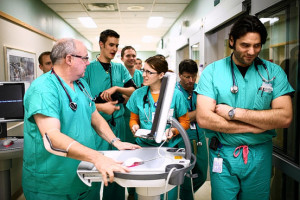 After 10-12 years of university, medical residents master survival skills under incredible pressure. Marching towards the end of training feels like walking to the deep end of a swimming pool. It gets really hard. You drown in debt. But you know the end promises a rapid rise to the surface.
After 10-12 years of university, medical residents master survival skills under incredible pressure. Marching towards the end of training feels like walking to the deep end of a swimming pool. It gets really hard. You drown in debt. But you know the end promises a rapid rise to the surface.
At least it used to. The Ontario government cancelled multiple programs for new graduates. It rationed entry into capitated practice models essentially eliminating them for most grads. ‘New patient’ enrolment fees and 1st year income stabilization were axed (the only source of income in capitated models). See Scott Wooder’s blog for more.
We all hope that some of our best students will sacrifice their youths in training to become physicians. Thoughtlessly slamming the door on any meaningful hope of using your training in Ontario for the next few years is callous and cruel. And it destroys a vital resource that compromises the care of those who need it most.
Listen to what residents and medical students have said on this blog and in email:
Mike says:
“I’m a soon to be family medicine grad and I’m just so upset with the changes our government is proposing. New grads doing family medicine who hoped for income stabilization during their first year will likely lose anywhere from 30-60% of what they would have earned. Like most people I have a new mortgage and bills. Unlike most people I have $200,000 of debt and have made numerous financial sacrifices to get to where I am with no pension, vacation pay, benefits or paid vacation in my future. My income needs to account for these.
Unfortunately, this policy has consequence that will fall on patients. I won’t be able to go out and start a family health team and roster patients. This won’t allow me to balance my books – there’s no incentive now to be a good family doctor. Instead I’ll have to do rushed fee for service walk-in and ask patients to only bring up one concern per visit. This is not what I got into medicine for.
Additionally, our most vulnerable patients who are so complex are having their attached health care dollars taken away. I worry that they will have a harder time getting care. Taking away any incentives to do after hours and weekends is going to push everyone into the emergency rooms where it costs 10-20x as much to treat them there. These policies are short sighted….
It’s a bad time for new family med grads and I hope our future is brighter and family doctors, and physicians in general, can really be part of the solution for optimizing care and reducing money in the system without impacting patient care.”
Matt says:
“As a R2 in family medicine I feel exactly the same as Mike. The recent changes that the Ontario government is imposing on physicians demonstrates how little respect they have for our profession. Unfortunately the coverage I have seen has not brought up the changes that are going to affect predominantly new grads.
As far as I understand, the income stabilization program has been removed and new grads are no longer allowed to join FHTs/FHOs and roster patients (other than in remote regions). This forces new grads to work in a fee-for-service model.
Income stabilization is incredibly helpful for a new grad. If a new grad is building a new practice (or joining a practice) and building a patient roster, they will need several patients before they have a positive cash flow. The income stabilization program ensured that physicians could build up a practice and still have enough take home to eat and pay off interest.
Fee-for-service has its benefits and drawbacks, most of which have been mentioned above. Overall complex patients tend to be overlooked in a fee-for-service model and physicians are essentially forced to either push through simple visits (ie. refills each month to have quick and easy appointments to bill) or to find other sources of income (block fees, non-OHIP covered services) if they want to make money and take care of complex patients.
Furthermore, a quick comparison of the OHIP SOMB and other provinces SOMBs (in particular Alberta’s SOMB) will demonstrate that several common billing codes pay significantly less in Ontario. Previously this didn’t matter as much in a patient rostered type model, however, with new grads being forced into fee-for-service models this makes a huge difference in realized income.
I feel very fortunate that I have the opportunity to “vote” on the policy by simply leaving the province. As a new grad I would prefer to serve a province that respects the work and value that I bring to my community. Unfortunately, several of my colleagues are stuck in Ontario due to family and mortgages.
The Ontario government has essentially balanced their healthcare budget by picking on the group of physicians (brand new family medicine grads, usually with > $150k student loans) who can afford it the least. This is akin to the bully in the playground preying on the kid who can’t defend himself.”
Stephen said:
“The concerns I’ve heard from fellow family medicine residents and those new in practice are largely centred around the changes that restrict their ability to practice patient-centred family medicine. Many have trained in family health teams and a significant amount wish to practice in a similar model. Unfortunately, the new changes restrict enrolment in these models to high-need areas (for which there is no clear definition!). Having being attracted to family medicine for the opportunity to practice team based care, there is a feeling that the rug is being pulled out from under them. Given the significant medical debt that residents carry coupled with the fact many have already starting setting up a life and family where they trained, relocating becomes very difficult. Many new and upcoming graduates are now taking a serious look at walk-in clinics given the restricted rostering options, loss of income stabilization for new graduates, and the various financial pressures facing them.”
And again, Matt says:
“…The government is balancing the budget by refusing new graduates the ability to roster patients…
…Again, this is not the entitled generation whining for more pay. This is a generation of new doctors who are being forced to work in a factory style family practice or move provinces. Both of these will end up affecting how you receive primary care in the future.”
Kevin said:
“I am also a PGY2 in family medicine. Some of my colleagues have already outlined my situation quite accurately above, and I wholeheartedly agree with them. My three points to add to the conversation are:
1)Directly due to the manner in which the cuts will affect new graduates in family medicine many are in the process of cancelling their plans to start a family practice in Ontario. The one alternative discussed above is to move to another province, but for many this is not ideal as we have partners/children/family to consider. The second solution that I am seeing is that we are opting to do only non-office based family medicine such ER, hospitalist, palliative care etc. Personally I had planned to start my office based practice July 1st, but this has been put on hold, and I am exploring hospital based work only. Common sense tells me this will not be a savings to OHIP as patients who would have been rostered to a new physician July 1st will now continue to access expensive ER services.
2)Although I understand the sentiment, the expression “Many of us would do this job for free” is very unhelpful and furthers the divide between new graduates and established physicians. I am not ashamed of saying that I will not do this job for free, I will not even do it for the vastly reduced compensation that is now being offered. Quite simply I can’t. I have $260,000 debt from medical school, 0% of my mortgage paid off, 0% of my retirement funded, and all the same household expenses as everyone else. I love the work I do, but I am governed by the same fiscal realities as everyone else.
3)The Ministry should make public what they feel is fair compensation for a family physician. Take into account debt load, overhead costs, a hypothetical 40hr work week and standard billing codes such as A007. Show new physicians and the public how many patients I need to see each week to achieve this “fair compensation”. How many minutes does this leave for each patient? I think the results of this would be very revealing.”
Brian said:
“As a medical student in clerkship, in the process of deciding my career path, I can say that the cuts to family medicine are a significant new deterrent to choosing Family over almost any other specialty. In my experience so far, FFS practice all-to-frequently leads to burned-out, cynical docs who resent their patients for being the tiniest bit complex. The cuts will not change this for the better, and I do not want that future for myself.
I find this all very sad, because I truly believe that family medicine is the most important – and potentially most personally rewarding – kind of medicine. But financial realism creeps in, and now I find myself having to “sell out” and consider which specialties/ practice model will allow me to enjoy a reasonable lifestyle and retire before 70, rather than choosing based on what I WANT to do. As was mentioned earlier by one of the very perceptive residents, this is not what we signed up for when we decided to become doctors. This was supposed to be a vocation, not a job; a life dedicated to patients, not to paying off our bottom line just to keep food on the table….”
If you know a medical student or resident, be especially nice to them right now. Even better, talk about this with your friends, write a letter to the editor or speak with your MPP. Taxpayers shouldn’t tolerate the government playing havoc with your healthcare.
photo credit: wsj.com


